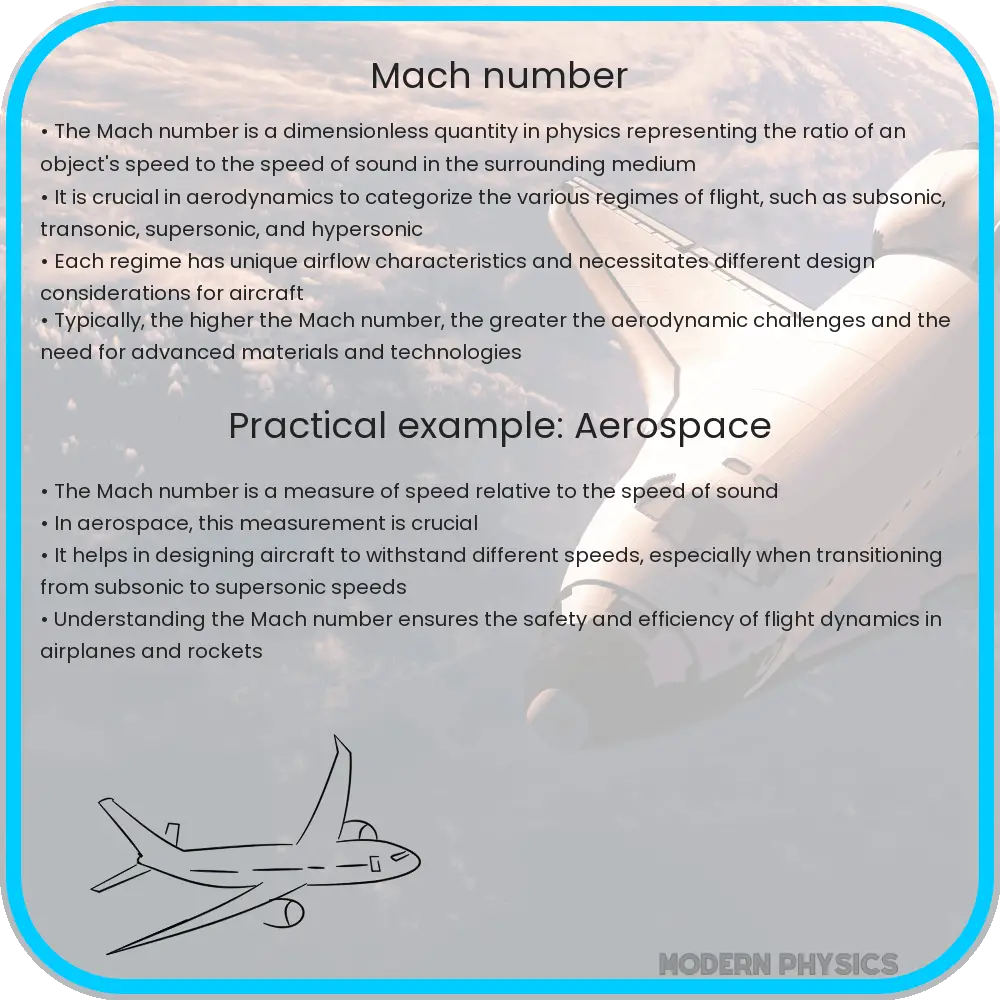Explore the significance of Mach Number in aerospace, covering its impact from subsonic to hypersonic speeds and future aerospace innovations.

Understanding Mach Number: Significance in Aerospace
The concept of Mach number is pivotal in the field of aerospace and aeronautics, serving as a crucial parameter in the design and analysis of aircraft and spacecraft. Named after Austrian physicist Ernst Mach, the Mach number (M) is a dimensionless unit that measures the speed of an object relative to the speed of sound in the surrounding medium. This measurement is not just a number; it embodies the complex interplay between aerodynamics, thermodynamics, and fluid dynamics.
Speed of Sound and Its Variability
At the heart of understanding Mach number is the speed of sound, which is not a constant value. It varies depending on environmental conditions, primarily temperature and, to a lesser extent, humidity and air composition. Typically, at sea level under standard atmospheric conditions, the speed of sound is approximately 343 meters per second (1,125 ft/s). However, this speed decreases with altitude due to lower temperatures, affecting the Mach number calculations for high-altitude flight.
Measurement of Mach Number
The Mach number is calculated by dividing the speed of an object (V) by the speed of sound (a) in the same medium. Mathematically, it is expressed as:
M = V / a
For example, an aircraft flying at 860 kilometers per hour (534 mph) at an altitude where the speed of sound is 320 meters per second (1,050 ft/s) would be flying at Mach 0.75.
Categories of Mach Number
Aerospace engineering classifies speeds into different regimes based on Mach number:
- Subsonic: Speeds less than Mach 1, where airflow around the object is entirely subsonic.
- Transonic: Speeds close to Mach 1, typically between Mach 0.8 to 1.2, where both subsonic and supersonic flows exist around the object.
- Supersonic: Speeds greater than Mach 1 but less than Mach 5, characterized by entirely supersonic airflow around the object.
- Hypersonic: Extremely high speeds, typically above Mach 5, where unique aerodynamic and thermodynamic phenomena occur.
Each of these regimes presents unique challenges and considerations in aircraft design, particularly in terms of aerodynamic heating, shock waves, and stability.
Impact of Mach Number on Aerospace Design
The Mach number significantly influences the design and operation of aircraft. At different Mach regimes, aircraft encounter various aerodynamic phenomena such as shock waves and boundary layer separation. These effects necessitate specific design considerations, such as the shape of the aircraft, material selection, and propulsion systems.
In the next section, we will delve deeper into the specific aerospace impacts of different Mach regimes, exploring how engineers and scientists address the unique challenges presented by supersonic and hypersonic speeds.
Aerospace Impacts of Different Mach Regimes
The impact of Mach number on aerospace engineering becomes particularly pronounced as aircraft approach and surpass the speed of sound. In the transonic range (Mach 0.8 to 1.2), aircraft encounter phenomena like shock waves and sonic booms, which can cause significant aerodynamic instability. Engineers address these challenges through specialized airframe designs, such as swept wings, which help to delay the onset of these effects.
In the supersonic regime (Mach 1 to 5), the challenges intensify. Here, aerodynamic heating becomes a critical concern. As an aircraft’s speed increases, the friction with air molecules generates significant heat, requiring the use of heat-resistant materials. For instance, the famous Concorde used a special aluminum alloy for its skin to withstand the temperatures experienced during supersonic flight.
The hypersonic regime (above Mach 5) presents the most extreme challenges. At these speeds, traditional air-breathing engines such as turbojets are no longer effective. Instead, hypersonic vehicles often rely on scramjets, a type of jet engine that can handle the high-speed airflow. Moreover, the intense heat and pressure at these speeds demand advanced materials like titanium and carbon-carbon composites.
Applications and Future of Mach Number in Aerospace
The applications of understanding Mach number extend beyond just passenger and military aircraft. In space exploration, rockets must exceed Mach 25 to escape Earth’s gravity, a feat that requires immense propulsion and heat shielding. The Mach number also plays a crucial role in the development of hypersonic missiles and re-entry vehicles, where precise control over speed and trajectory is vital.
Looking to the future, the pursuit of higher Mach numbers continues to drive innovation in aerospace engineering. Projects like NASA’s X-43, which achieved Mach 9.6, push the boundaries of what is possible, paving the way for faster global travel and new frontiers in space exploration.
Conclusion
In conclusion, the Mach number is much more than a simple speed measurement; it’s a fundamental concept that shapes the entire field of aerospace engineering. From subsonic passenger jets to hypersonic space vehicles, understanding and mastering Mach number is key to overcoming the unique challenges presented at different speeds. As technology advances, the pursuit of higher Mach numbers promises to bring about breakthroughs in materials, propulsion, and aerodynamics, ultimately expanding the horizons of human capability in both air and space travel.
